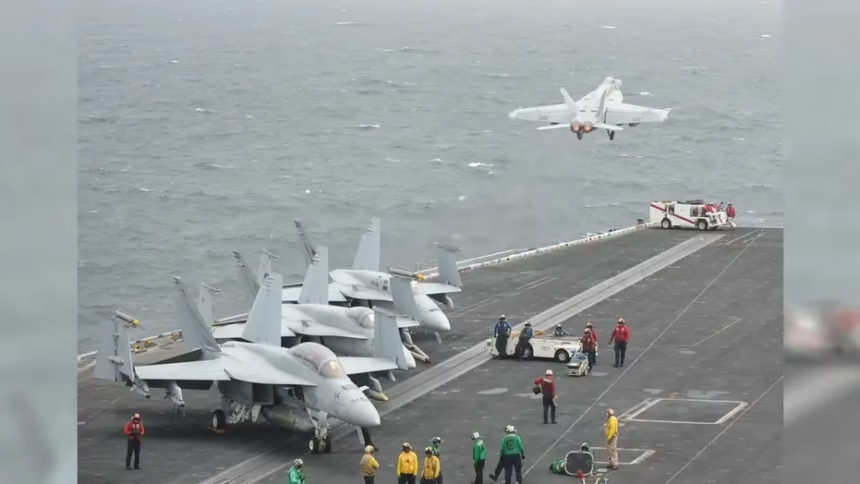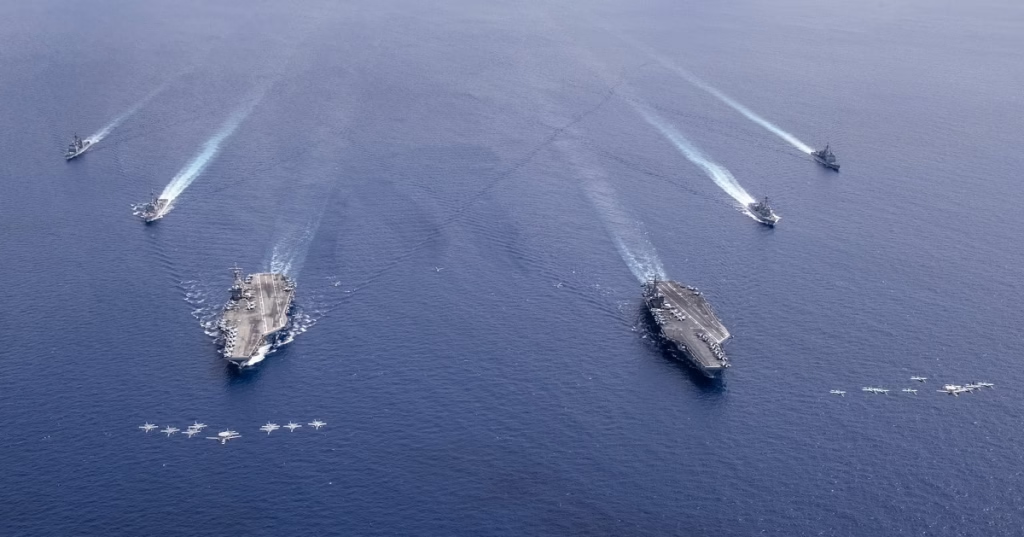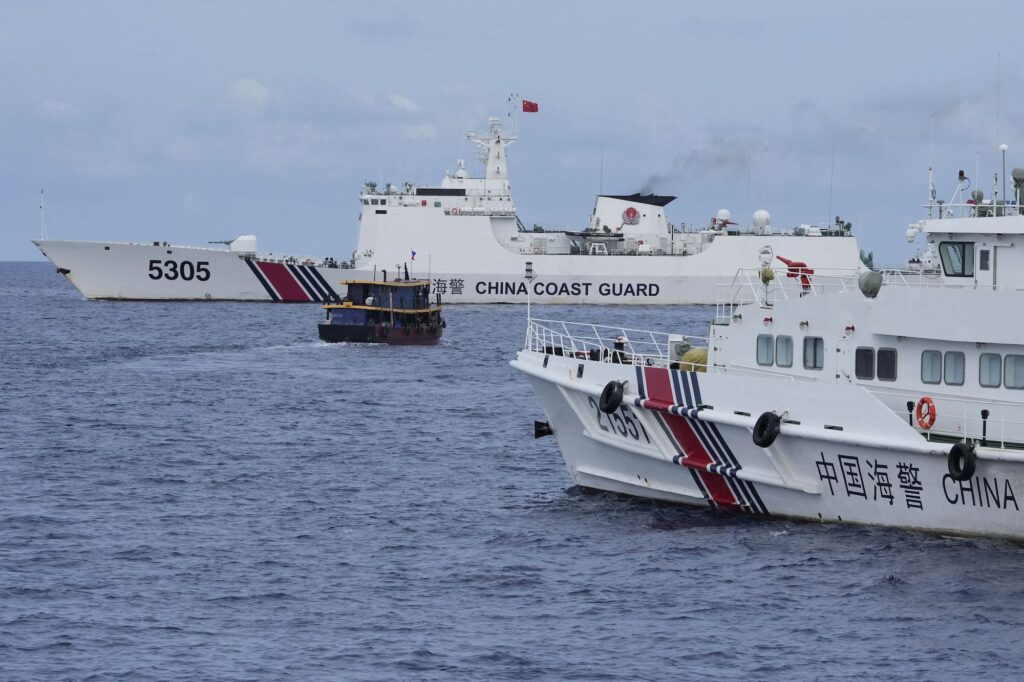SOUTH CHINA SEA – Two US Navy aircraft, an MH-60R Sea Hawk helicopter and an F-18 Super Hornet, went down in the South China Sea on Sunday afternoon during routine operations from the aircraft carrier USS Nimitz.
The losses, only 30 minutes apart, have sharpened concerns about operational strain in one of the world’s most contested waters as US-China friction grows. The first incident occurred at about 2:45 p.m. local time.
A Sea Hawk from Helicopter Maritime Strike Squadron 73, known as the Battle Cats, crashed while on a standard patrol. The MH-60R supports anti-submarine warfare, search and rescue, and surface strike missions.
Carrier Strike Group 11 recovered all three crew members. They were taken back to the USS Nimitz and remain in stable condition.
Roughly half an hour later, at 3:15 p.m., an F/A-18F Super Hornet from Strike Fighter Squadron 22, the Fighting Redcocks, also went down. The two aviators ejected and were rescued from the water.
The Super Hornet, a twin-engine, carrier-based fighter used for air defence and precision strikes, is central to the Navy’s air arm. Each jet costs over $60 million. This is the fourth Super Hornet lost in the past year, after earlier losses linked to operations in the Red Sea.
The US Pacific Fleet said no one suffered serious injuries. All five service members are safe and accounted for. Investigators are looking at possible mechanical issues, weather, or pilot error. Officials have ruled out foul play for now.
A fleet spokesperson called the events routine operations, although the back-to-back crashes have prompted questions about pressure on older platforms, including the 50-year-old Nimitz.
US Navy Presence Under Scrutiny in a Strategic Waterway
The crashes came as the United States maintains a high-profile presence in the South China Sea, a key route for global trade worth an estimated $3.36 trillion each year. The region also carries most of China’s energy imports.
The Nimitz Carrier Strike Group entered the area in early October after months in the Middle East responding to Houthi threats. The deployment reinforces Washington’s commitment to freedom of navigation. Carrier strike groups crossed the sea eight times last year, and that pace is expected to continue under the Trump administration’s Indo-Pacific policy.
US activity goes well beyond carriers. In May, the destroyer USS Dewey conducted a freedom of navigation operation near the Spratly Islands, sailing within 12 nautical miles of disputed features. Exercises such as Cope Thunder Philippines 2025 brought F-35 aircraft to Philippine bases, strengthening coordination with Manila under the mutual defence treaty.
Washington is also investing up to $5 million to improve Naval Detachment Oyster Bay in the Philippines, a staging point for patrols and resupply runs to locations like Second Thomas Shoal. These steps, tied to cooperation with Australia, Japan, and Vietnam, seek to deter coercion and support international law, including the 2016 Hague ruling that rejected China’s expansive nine-dash line.
A heavy operational tempo adds strain. Carrier Air Wing 17 has flown thousands of sorties since leaving San Diego in March, working through monsoon turbulence and the mental load of operating close to Chinese forces. Analysts warn that stretched resources, diversions to the Red Sea, and budget pressures under a partial government shutdown can raise risks. Navy leaders say readiness remains strong.
Beijing’s Moves Keep the Pressure High
China’s sweeping claims over most of the 3.5 million square kilometres of the South China Sea, which overlap with the Philippines, Vietnam, Malaysia, Brunei, and Taiwan, have intensified in 2025. Military build-up and grey-zone tactics have escalated without tipping into open conflict.
In August, Chinese Coast Guard and militia vessels surrounded a Philippine fisheries ship near Sabina Shoal, ramming it and blasting it with water cannons to disrupt resupply efforts. In September, satellite images showed a new floating barrier at Scarborough Shoal, closing off the lagoon. Manila condemned the move as illegal.
These actions fit a steady pattern. Since 2022, Chinese ships have rammed Philippine coast guard vessels, once filmed by a US news crew. Beijing has deployed large numbers of Chinese Coast Guard units and militia boats to enforce control.
In March, Australian patrols near the Paracels reported harassment by Chinese Coast Guard ships, including flares released close to aircraft.
China’s Southern Theatre Command regularly warns off US and allied forces, calling freedom of navigation operations destabilizing. Critics, such as the George W. Bush Presidential Center, describe a slow squeeze through incremental moves, including artificial islands, airstrips, and missile sites on reclaimed reefs.
The human impact is clear. Filipino sailors have suffered injuries from water cannon blasts. Fishermen are blocked from traditional grounds. Trade worth trillions could face disruption if tensions spike.
ASEAN and China agreed on a three-year window in October to finalize a Code of Conduct, but talks have made little headway. The Philippines, under President Ferdinand Marcos Jr., has taken a firmer line, widening US access to bases and signing new defence agreements with Japan. China’s tactics, which stop short of outright conflict, are testing resolve across the region.
The Nimitz will continue operations after the crashes, which highlight how quickly routine flights can turn hazardous in these waters. With President Trump set to tour Asia and meet China’s leader Xi Jinping, the timing adds pressure on diplomacy. Washington says it will press on with freedom of navigation operations, allied exercises, and the use of unmanned systems to maintain presence without overextending crews.
For the crews rescued on Sunday, the outcome was as good as it gets. In a sea this contested, and with major powers circling, good fortune is no plan. As one retired admiral put it, the sea punishes mistakes, and geopolitics does too. The world is watching for what comes next.
















